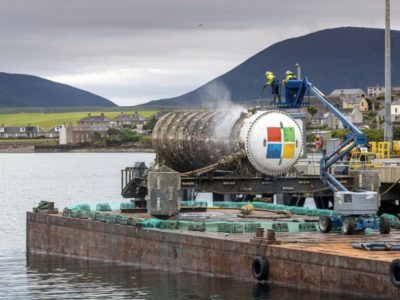Data centers are essential for smooth operations at all organizations. And demand will grow with the adoption of increasingly data-intensive technologies such as artificial intelligence, smart and connected energy systems, blockchain, distributed manufacturing systems, and autonomous vehicles.
Data centers are energy-intensive enterprises, estimated to account for around 1% of worldwide electricity use, and about 40 percent is due to equipment cooling.
The idea of an underwater data center came from an employee program at Microsoft intended to generate out-of-the-box ideas. Land-based data centers are typically situated in remote locations where land is inexpensive. But roughly half of the world’s population lives within 120 miles of a coast. The more distance the data travels to reach customers, the slower the speed. But underwater data centers could be located off the shore of population centers and provide faster response times.
After a preliminary proof-of-concept, Microsoft conducted a successful 2-year research experiment in using seawater to cool data center servers. They worked with the Naval Group, a France-based company with global expertise in submarines and marine energy technologies. Phase two of Project Natick was deployed on the seafloor in the Northern Isles at 117 feet deep in spring 2018.
Project Natick’s 40-foot long data center in a submarine-like vessel was loaded with 12 racks containing 864 servers and associated cooling system infrastructure. The data center was assembled and tested in France and shipped on a flatbed truck to Scotland, where it was attached to a ballast-filled triangular base for deployment on the seabed.
Natick’s engineers used solutions from the marine industry and submarines to solve design challenges. These included keeping the inside of the big steel container dry, figuring out the best way to use the seawater to cool the servers inside, and keeping off the barnacles and other forms of sea life that cover a submerged vessel that could interfere with the heat transfer process. During the test, the lights-out data center’s failing servers were taken offline.
Underwater data centers need to maintain a steady temperature, humidity, and airflow like land-based data centers. Plus, because the servers are in a sealed container, they also had to include equipment to vary air pressure. An air-to-liquid heat exchanger, similar to those used in submarines was installed between each pair of racks was used for cooling. Each heat exchanger’s fans pushed the air, and seawater was pulled in from outside and run in a loop through the heat exchanger and back out to the ocean.
On land, varying climate conditions including temperature, affect the reliability of identical equipment, so performance often varies by location. But the ocean provides a consistent, cool temperature.
Further, the ocean provides a uniform environment, unlike land-based centers, which are subject to local building codes. And, future underwater data centers can be co-located with offshore wind farms or tidal energy to use renewable energy.
After two years, in July 2020, the Natick Northern Isle data center was retrieved for analysis. Microsoft reports that its server failure rate was 1/8 of its land-based control group. It is possible that the lower failure rate is due to the vessel being pumped full of nitrogen rather than oxygen which when combined with humidity and temperature fluctuations causes corrosion.
Next, in 2021, China’s Highlander, a maritime technology company, announced the world’s first commercial underwater data center in the Guangdong Province of Zhuhai.
And now, a US-based start-up company, Subsea Cloud, is proposing deep-sea data centers.
China’s Highlander and Microsoft’s Natick used gas-filled vessels in shallow coastal waters at depths of around 120m (400ft).
Subsea Cloud claims their pressure-tested liquid-cooled underwater data center pods (UDCPs) can operate lights-out on the sea bed at 3,000m (9482 feet). At that depth, the only way to access the data center is by a trackable, remotely operated vehicle (ROV), providing an extra layer of security.
Subsea’s full-scale pod takes only 12 weeks to manufacture and deploy. The company says their pods reduce latency (data transmission delays) by up to 98% and reduce energy consumption and emissions by 40%.








